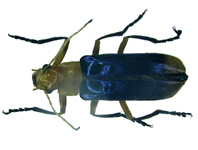Abstract
A new species of Astropecten is described, supported by morphological and molecular evidence, from the Gulf of Mexico and the East Florida Shelf with most specimens from 30–60 m in depth. The new species, A. mcedwardi n. sp., is small, with a maximum major radius < 30 mm. Specimens of A. mcedwardi n. sp. have been found in five museums as an undescribed species or misidentified under several names. The spination of the oral surface most closely resembles that of Astropecten antillensis Lütken, 1859 from the Caribbean, but the body form is similar to that of Astropecten duplicatus Gray, 1840, which is found in the same geographic range. Examination of specimens from different collections indicates that the new species may overlap in distribution with A. antillensis along the East Florida Shelf. Sequencing and phylogenetic analysis of two mitochondrial genes reveal that A. mcedwardi is closely related to A. antillensis but that its phylogenetic lineage is distinct from that of A. antillensis.
References
Benavides-Serrato, M., Borrero-Pérez, G.H. & Diaz-Sanchez, C.M. (2011) Equinodermos del Caribe Colombiano I: Crinoidea, Asteroidea y Ophiuroidea. Serie de Publicaciones Especiales de Invemar 22. Museo de Historia Natural Marina de Columbia, Santa Marta, Columbia, 384 pp.
Caso, E.M. (1990) Un nuevo asteroideo del Caribe mexicano. Astropecten caribemexicanenesis sp. nov. y comparación con la especie afín Astropecten nitidus Verrill. Anuales del Instituto de Ciencia del Mar y Limnología. Universidad Nacional Autónoma de México, 17 (1), 107–130.
Clark, A.M. & Downey, M.E. (1992) Starfishes of the Atlantic. Chapman and Hall, London, 794 pp.
Clarke, K.R. & Gorley, R.N. (2006) PRIMER v6: User Manual/Tutorial. PRIMER-E, Plymouth, Massachusetts, 192 pp.
Gray, J.E. (1840) A synopsis of the genera and species of the class Hypostoma (Asterias Linnaeus). Annals of the Magazine of Natural History, Series 1, 6 (37), 175–184 + 275–290.
https://doi.org/10.1080/03745484009443296
Hoareau, T.B. & Boissin, E. (2010) Design of phylum-specific hybrid primers for DNA barcoding: addressing the need for efficient COI amplification in the Echinodermata. Molecular Ecology Resources, 10 (6), 960–967.
https://doi.org/10.1111/j.1755-0998.2010.02848.x
Katoh, K. & Standley, D.M. (2013) MAFFT multiple sequence alignment software version 7: improvements in performance and usability. Molecular Biology and Evolution, 30 (4), 772–780.
https://doi.org/10.1093/molbev/mst010
Lawrence, J.M., Cobb, J.C. & Herrera, J.C. (2016) Synonymy of Astropecten comptus Verrill, 1915 with Astropecten articulatus (Say, 1825). Florida Scientist, 79 (supplement 1), 22.
Lawrence, J.M., Cobb, J.C. & Herrera, J.C. (2018a) Synonymy of Astropecten nitidus Verrill, 1915 with Astropecten cingulatus Sladen, 1883 and Astropecten comptus Verrill, 1915 with Astropecten articulatus (Say, 1825). Bulletin of the Peabody Museum of Natural History, 59 (2), 127–157.
https://doi.org/10.3374/014.059.0203
Lawrence, J.M., Cobb, J.C., Herrera, J.C., Durán-González, A. & Solís-Marín, F.A. (2018b) Morphological comparison of Astropecten cingulatus and a new species of Astropecten (Paxillosida, Astropectinidae) from the Gulf of Mexico. Zootaxa, 4407 (1), 86–100.
https://doi.org/10.11646/zootaxa.4407.1.5
Lütken, C. (1859) Bidrag til Kundskab om de ved Kysterne af Mellem-og Syd-America levende arter af Sostjerner. Videnskabelige Meddelelser fra Dansk Naturhistorisk Forening, 1859, 25–96.
Mah, C. & Hansson, H. (2008) Astropecten. In: Mah, C.L. (2016) World Asteroidea database. Available from: World Register of Marine Species. Available from: http://www.marinespecies.org/aphia.php?p=taxdetails&id=123245 (accessed 24 May 2016)
Matsubara, M., Komatsu, M., Araki, T., Asakawa, S., Yokobori, Shin-ichi, Watanabe, K. & Wada, H. (2005) The phylogenetic status of Paxillosida (Asteroidea) based on complete mitochondrial DNA sequences. Molecular Phylogenetics and Evolution, 36 (3), 598–605.
https://doi.org/10.1016/j.ympev.2005.03.018
Palumbi, S.R., Martin, A., Romano, S., McMillan, W.O., Stice, L. & Grabowski, G. (1991) A Simple Fool’s Guide tom PCR. Version 2.0. University of Hawaii, Honolulu, Hawaii, 47 pp.
Pawson, D.L., Vance, D.J., Messing, C.G., Solís-Marín, F.A. & Mah, C.L. (2009) Echinodermata of the Gulf of Mexico. In: Felder, D.L. & Camp, D.K. (Eds.), Gulf of Mexico—Origins, Waters, and Biota. Biodiversity. Texas A&M University Press, College Station, Texas, pp. 1177–1204.
Perrier, E. (1881) Description sommaire des espèces nouvelles d′Astéries. Bulletin of the Museum of Comparative Zoology, 9 (1), 1–31.
Say, T. (1825) On the species of the Linnaean genus Asterias inhabiting the coast of the U.S. Journal of the Academy of Natural Sciences of Philadelphia, 5, 141–154.
Sladen, W.P. (1883) The Asteroidea of HMS Challenger Expedition—Part II. Astropectinidae. Zoological Journal of the Linnean Society, 17, 214–269.
https://doi.org/10.1111/j.1096-3642.1883.tb02022.x
Sladen, W.P. (1889) Report on the Asteroidea. Report on the Scientific Results of the Voyage of H.M.S. Challenger during the years 1873–1876. Zoology, 30 (51), i–xlii + 1–893, 118 pls.
Stamatakis A. (2006) RAxML-VI-HPC: maximum likelihood-based phylogenetic analyses with thousands of taxa and mixed models. Bioinformatics, 22 (21), 2688–2690.
https://doi.org/10.1093/bioinformatics/btl446Ventura, C.R.R. (2013) Astropecten. In: Lawrence, J.M. (Ed.), Starfish: Biology and Ecology of the Asteroidea. The Johns Hopkins University Press, Baltimore, Maryland, pp. 101–108.
Verrill, A.E. (1880) Notice of the remarkable marine fauna occupying the outer banks off the southern coast of New England. American Journal of Science, 3 (20), 390–403.
https://doi.org/10.2475/ajs.s3-23.137.406
Verrill, A.E. (1915) Report on the starfishes of the West Indies, Florida, and Brazil, including those obtained by the Bahama expedition from the University of Iowa in 1893. Bulletins from the Laboratories of Natural History of the State University of Iowa, 7 (1), 1–232.
Zanol, G., Baleiras-Couto, M.M. & Duarte, F.L. (2010) Restriction profiles of 26S rDNA as a molecular approach for wine yeasts identification. Ciência e Técnica Vitivinícola, 25 (2), 75–85.
Zulliger, D.E. & Lessios, H.A. (2010) Phylogenetic relationships in the genus Astropecten (Paxillosida: Astsropectinidae) on a global scale: molecular evidence for morphological convergence, species-complexes and possible cryptic speciation. Zootaxa, 2504 (1), 1–19.
https://doi.org/10.11646/zootaxa.2504.1.1

